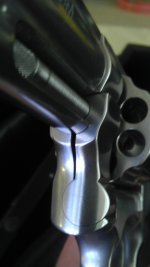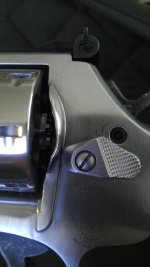I purchased a new 686 Plus with a 4 inch barrel in December - my first revolver. After taking it to the range for the first time, I noticed a blemish on the finish - a pit on the outside of the barrel. Having just dropped a lot of money on it, contacted S&W about getting it fixed. I went through the normal warranty process; they sent me a fedex label, I sent it to them with a description of the problem, and it arrived back to me two weeks to the day. The blemish on the barrel finish was corrected, BUT there was a new problem. It came back to me jammed/locked up. The cylinder was completely stuck and unmovable in a not-all-the-way-closed position, and the cylinder release was in the forward position (where you push it to to release the cylinder) and completely unmovable also. (see attached pictures)
I immediately called S&W. They apologized and sent me another fedex label to send it back to them again. I got it back yesterday, and it is no longer jammed. However, they included a piece of paper that said there was nothing wrong with the gun when they got it, so they're just sending it back to me. Obviously they did SOMETHING, because they it's working now. The skeptic in me guesses they unjammed it and didn't want to document that they did anything wrong in the first place. Now I'm nervous about the condition of my gun. So, a few questions:
1) any guess, based on the description and the pictures, what might've caused the jam in the first place?
2) should I be concerned about my gun? I don't SEE anything wrong, but I'm terrified that my new baby is worse for ware or the alignment/tuning is poorer or some part is bent slightly more than it used to be after being like that for so long (probably at least a week). Because S&W didn't give me any info on what they did with it the second time, I'm worried that I might just be behaving like a hypochondriac or a new parent, but I don't know enough about revolver movements and fit and finish to know if I should be concerned about something I can't see or not. And without knowing, I'm left to imagining what might be wrong - is an important part warped now? is the alignment worse?there's a little rotational wiggle in the cylinder, is it more than there was before? stuff like that.
I'm not opposed to taking it to the gunsmith at the shop where I got it, but the last time I went in there with a question they treated me REALLY poorly and just kindof made snarky comments. So, if there's reason to want a gunsmith to check it out, I'll suck it up and have them look at it (they're the only ones in my area), but I'd just as rather not if there's no need to. If I'm just being a worry-wart, it would be a relief to be told that, too.
Thanks for the help
I immediately called S&W. They apologized and sent me another fedex label to send it back to them again. I got it back yesterday, and it is no longer jammed. However, they included a piece of paper that said there was nothing wrong with the gun when they got it, so they're just sending it back to me. Obviously they did SOMETHING, because they it's working now. The skeptic in me guesses they unjammed it and didn't want to document that they did anything wrong in the first place. Now I'm nervous about the condition of my gun. So, a few questions:
1) any guess, based on the description and the pictures, what might've caused the jam in the first place?
2) should I be concerned about my gun? I don't SEE anything wrong, but I'm terrified that my new baby is worse for ware or the alignment/tuning is poorer or some part is bent slightly more than it used to be after being like that for so long (probably at least a week). Because S&W didn't give me any info on what they did with it the second time, I'm worried that I might just be behaving like a hypochondriac or a new parent, but I don't know enough about revolver movements and fit and finish to know if I should be concerned about something I can't see or not. And without knowing, I'm left to imagining what might be wrong - is an important part warped now? is the alignment worse?there's a little rotational wiggle in the cylinder, is it more than there was before? stuff like that.
I'm not opposed to taking it to the gunsmith at the shop where I got it, but the last time I went in there with a question they treated me REALLY poorly and just kindof made snarky comments. So, if there's reason to want a gunsmith to check it out, I'll suck it up and have them look at it (they're the only ones in my area), but I'd just as rather not if there's no need to. If I'm just being a worry-wart, it would be a relief to be told that, too.
Thanks for the help


